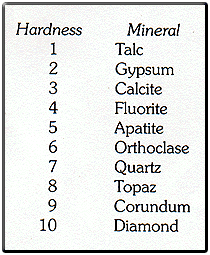what makes a mineral a mineral?
The properties of minerals: There are seven main properties that are used to describe and classify any mineral found. All seven properties are explained below. The definitions of all the seven properties of minerals can also be found in the Basics section of this lesson.
Crystal form refers to the external appearance of a mineral, as determined by its molecular structure.
Luster is the color or quality of the light reflected by a mineral. Metals reflect the most light, like mirrors, and are described as having a "metallic luster".
Color is self explanatory. Keep in mind that many minerals have several different forms with different colors, even while having one chemical formula. This makes categorization by color an ineffective way to use the properties of minerals, to classify them.
Streak refers to the color of a mineral where it is scratched, or the color of that mineral in its powdered form.
Cleavage is the tendency of a mineral to break along planes, or lines, into orderly shapes like polygons or sheets. The mineral mica cleaves along straight, sheet-like planes and is used to make pool tables (see the multimedia section of this lesson on cleavage for picture). Not all minerals exhibit cleavage.
Fracture describes what happens to a mineral when it is broken into pieces. Minerals that do not display cleavage shatter into random shapes. Silica, or glass, is a great example of a mineral that has no cleavage, but rather fractures into random pieces when it is shattered.
Hardness is just that: a measure of how hard, or resistant to scratching and compression, a mineral is. Diamond is the hardest mineral known, and is assigned a hardness value of ten. The hardness scale goes from one to ten, and is shown below featuring ten common minerals and their relative hardness'.
